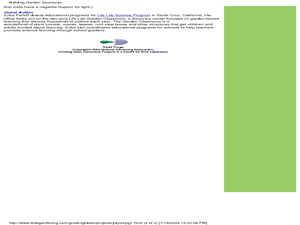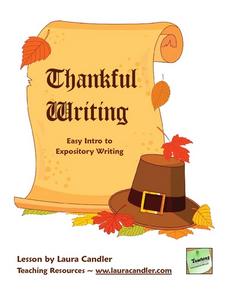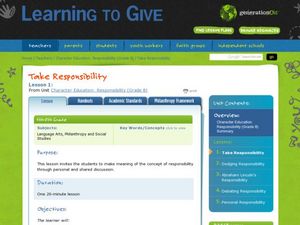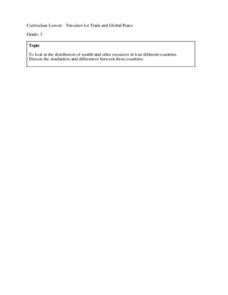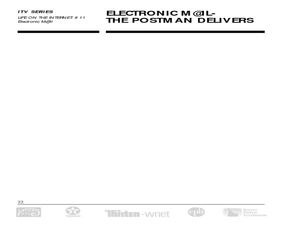Curated OER
Homes Sweet Homes
Students view various examples of homes by Robert Harris. In groups, they describe how houses are different in various climates around the world. Individually, they use one artifact from their own home and research its significance in...
Curated OER
Street Language
Learners consider the impact of language. In this literacy lesson plan, students read an article about literary classics being rewritten in "youth speak" (the article is not included). Learners read and discuss the article.
Curated OER
Classification
Students investigate how different types of food can be classified then counted. In this sorting, arranging, and classifying lesson plan, students explore how to group foods based on commonalities. Students are asked four questions which...
Curated OER
Growing Up (And Around, and Down...) Exploring Plant Growth
Students build plant growing structures. In this plant growth lesson, students plant growth structures such as a garden tepee or a crawl through tunnel. They grow plants that are appropriate for the structure.
Curated OER
Group Initiatives
Students explore the names and qualities about members in the group. They each say their name and something about themselves. Students gather around in a circle. They listen to the teacher as he or she says the name of someone and throws...
Curated OER
"Julie of the Wolves"
Fifth graders research life in Alaska and compare life there to their lives in this instructional activity. They read "Julie of the Wolves." They research through the novel and other reference books facts about the Alaskan climate and...
Curated OER
Everyone Eats Bread
Pupils identify similarties and differences between different countries and what type of bread they eat. They examine the different cultures of countries by emailing people in other countries. They also locate the country on the map.
Curated OER
Techniques Used to Convey Messages in Media
Students examine different types of media. In this media awareness lesson, students discover techniques used in print, language, symbolic, and technical media as they rotate through classroom station activities.
Curated OER
Mouthwatering Mollusks
Learners investigate various forms of aquatic life. They use four senses, touch, taste, smell, and observation to explore mollusks. Students cook and taste various types mollusks, such as mussels, scallops, and squid.
Curated OER
Enrichment Activities - "Mrs. Frisby and the Rats of NIMH"
Fifth graders read the novel "Mrs. Frisby and the Rats of NIMH." They discuss the various characters in the book, and the different types of conflict that take place within the book. They also research owls and rats to make comparisons...
Curated OER
A Tall Ship and a Star to Steer Her By
Learners create a water transportation device powered by wind. In this wind power lesson, students research transportation concepts after reading the poem "Sea Fever" by John Masefield. Learners design the fastest sailboat they can...
Curated OER
Thankful Writing
Students go through the entire writing process to create an expository essay about what they are thankful for. They use graphic organizers to guide them through the process.
Curated OER
Make Your Own Petroglyph!
Pupils create their own petroglyph. In this petroglyph lesson plan, students study and compare various petroglyphs. They create their own petroglyph to symbolize the seasons.
Curated OER
Take Responsibility
Students examine the importance of responsibility. In this character education lesson, students participate in a group discussion to explore and define responsibility.
Curated OER
Translations, Reflections, and Rotations
High schoolers are introduced to the concepts of translation, reflection, and rotation. They practice translating, reflecting, and rotating two-dimensional objects on the coordinate plane. students use computers to learn about the three...
Curated OER
Travelers for Trade and Global Peace
Learners explore the resources in other countries. In this communities lesson, students examine characteristics of their community to those of other communities. Learners examine Canada, El Salvador, and India and their natural resources.
Curated OER
Meet Danitra Brown Lesson on Friendship
Students discover the qualities of friends. In this character education lesson, students read the poem "Coke-bottle Brown" by Nikki Grimes. Students then discuss the Golden Rule and how it applies to friendships.
Curated OER
Electronic Mail - The Postman Delivers
Students examine the use of electronic mail. In this electronic mail instructional activity, students determine how to use different e-mail programs and how they access information using this medium. They discuss how e-mail differs from...
Curated OER
Salinity
Learners define and discuss salinity, conduct classroom experiment to determine salinity of water sample by using hydrometer, record predictions, and demonstrate understanding of how salinity influences object's ability to float in water.
Curated OER
DANCE
Students create and perform a dance or series of movements one to two minutes in length. Their dance supports and enhances the expressive qualities of the theater production and accompany the music students selected to perform.
Curated OER
Earthquake Waves And Their Destructions
Young scholars investigate primary and secondary waves and how to measure the magnitude of waves. They discover how to find the epicenter of earthquakes. They examine why waves are more destructive in some areas than others through these...
Curated OER
Learning Cycle Lesson Plan #6 (Misconception)
Ninth graders investigate evolution via natural selection and form an opinion. They support their opinion using scientific evidence and apply this to adaptations that have allowed certain organisms to survive.
Curated OER
Left Foot, Right Foot
Students listen to "The Foot Book", by Dr. Seuss. They participate in a discussion/activity about the book and feet. They trace their feet, label them 'left foot' and 'right foot' and compare their drawings to one another.
Curated OER
Visual Puns or Composite Imagery
Students discover art that contains composite imagery and visual puns. They create their own picture of composite imagery and explain the visual pun. Students develop skills using the drawing media.





